
Original Link: https://www.anandtech.com/show/2754
AMD's Phenom II X4 955 Black Edition
by Anand Lal Shimpi on April 23, 2009 12:00 AM EST- Posted in
- CPUs
Die size hasn’t changed, clock speeds barely went up, and performance per clock also remained static. But what’s this?
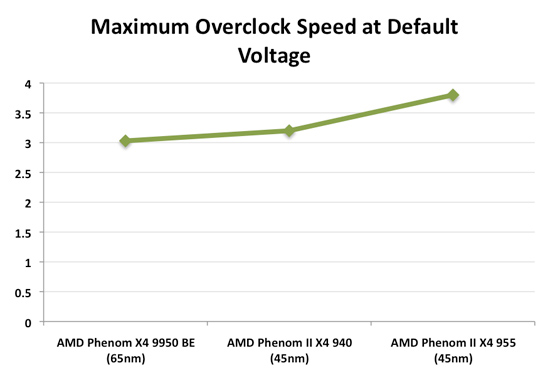
Ah yes, AMD is improving its 45nm manufacturing process and today we have the latest incarnation of AMD’s 45nm silicon.
The first versions of AMD’s 45nm Phenom II couldn’t really go much higher than the final 65nm Phenom without increasing voltage. By comparison, Intel’s Core i7 920 could go from 2.66GHz all the way up to 3.80GHz without so much as a single extra millivolt in our tests.
This new Phenom II however can also hit 3.80GHz without increasing the core voltage. At least that’s what one of our samples did in our testing. Whether it’s 3.8GHz or 3.6GHz, the fact of the matter is that AMD’s 45nm process is improving and that’s what’s behind todays introduction of the Phenom II X4 955. Architecturally the Phenom II hasn't changed; if you're curious about what makes these things tick, please look at our original article on the CPU.
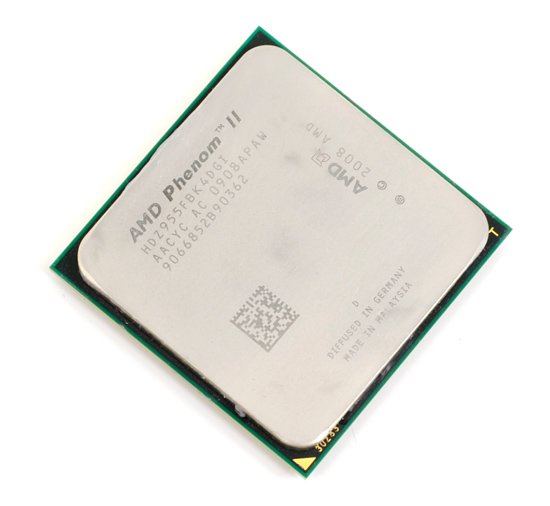
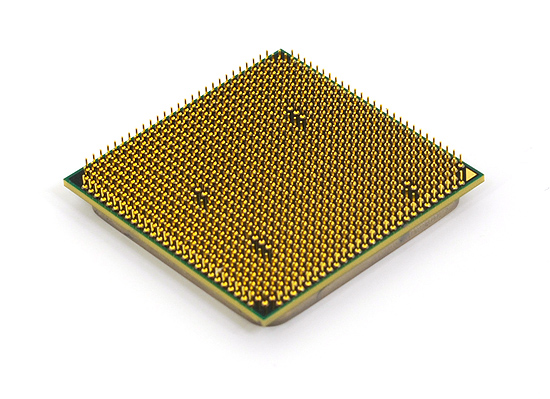
Clocked at 3.2GHz with a 2.0GHz un-core (or North Bridge) frequency, the 955 isn’t that much different from the 940 in terms of clock speed. The two face off in the table below:
| CPU | Clock Speed | un-core Clock (NB Frequency) | Die Size | Transistor Count | TDP | Socket |
| Phenom II X4 955 | 3.2GHz | 2.0GHz | 258 mm2 | 758M | 125W | AM3 or AM2+ |
| Phenom II X4 940 | 3.0GHz | 1.8GHz | 258 mm2 | 758M | 125W | AM2+ |
This is a Socket-AM3 part, meaning it can work in both DDR2 based Socket-AM2+ motherboards and DDR3 based Socket-AM3 motherboards. There’s a huge compatibility caveat about AM2+ support but I’ll address that shortly. The Phenom II X4 955 is also a Black Edition part, meaning it has an unlocked clock multiplier for easy overclocking.

Along with the 955 there’s also a 945 being introduced today. The 945 is identical to the 940 in core clock speed but has a 2.0GHz un-core and is also AM3 compatible.
| Processor | Clock Speed | un-core Clock | L2 Cache | L3 Cache | TDP | Price |
| AMD Phenom II X4 955 BE | 3.2GHz | 2.0GHz | 2MB | 6MB | 125W | $245 |
| AMD Phenom II X4 945 | 3.0GHz | 2.0GHz | 2MB | 6MB | 125W | $225 |
| AMD Phenom II X4 940 BE | 3.0GHz | 1.8GHz | 2MB | 6MB | 125W | $225 |
| AMD Phenom II X4 920 | 2.8GHz | 1.8GHz | 2MB | 6MB | 125W | $195 |
| AMD Phenom II X4 910 | 2.6GHz | 2.0GHz | 2MB | 6MB | 95W | $??? |
| AMD Phenom II X4 810 | 2.6GHz | 2.0GHz | 2MB | 4MB | 95W | $175 |
| AMD Phenom II X4 805 | 2.5GHz | 2.0GHz | 2MB | 4MB | 95W | $??? |
| AMD Phenom II X3 720 BE | 2.8GHz | 2.0GHz | 1.5MB | 6MB | 95W | $145 |
| AMD Phenom II X3 710 | 2.6GHz | 2.0GHz | 1.5MB | 6MB | 95W | $125 |
| AMD Phenom 9950 | 2.6GHz | 2.0GHz | 2MB | 2MB | 140W | $173 |
The prices are pretty attractive; the 955 will sell for $245 (and it already has been) and the 945 will go for $225. That pits the 955 against Intel’s Core 2 Duo Q9550 ($266) and the Core i7-920 ($284), the latter having a much higher motherboard cost of course.
| Processor | Price |
| Intel Core i7-920 (2.66GHz) | $284 |
| Intel Core 2 Quad Q9650 (3.00GHz) | $316 |
| Intel Core 2 Quad Q9550 (2.83GHz) | $266 |
| Intel Core 2 Quad Q9400 (2.66GHz) | $213 |
| Intel Core 2 Quad Q8400 (2.66GHz) | $183 |
| Intel Core 2 Quad Q8300 (2.50GHz) | $183 |
| Intel Core 2 Quad Q8200 (2.33GHz) | $163 |
And you know how I love spoiling surprises so here you have it. Unless you’re running applications that are very well optimized for Intel’s architectures, the Phenom II X4 955 is faster than the Core 2 Quad Q9550. Compared to the Core i7-920, it loses hands down although the chip does come close in some games.
Sorry, I’m not much of a tease :) Now for the rest of the article.
Painfully Backwards Compatible
AMD’s big selling point of its Socket-AM3 processors is that they can still be used in Socket-AM2+ motherboards. In other words, you can use them in DDR3 or DDR2 motherboards. There’s a catch - the Phenom II X4 955 needs a BIOS update to work properly. And guess what? Not all motherboards have that BIOS support yet.
It’s not a major change but the fact of the matter is that AMD and its board partners have not done the work necessary to enable support across the board at launch. That means that if you have a Socket-AM2+ board, you may not be able to run the Phenom II X4 955 just yet.

Socket-AM2+
I ran into this problem with my AM2+ testbed. For the past couple of AMD reviews I’ve used MSI’s DKA790GX Platinum, a 790GX based motherboard. AMD actually sent me the board with my first Phenom II X4 940. Unfortunately it doesn’t have an updated BIOS, so the 955 only runs at 800MHz and won’t POST at 3.2GHz. Great.
The following AM2+ boards currently have support for the 955:
| Motherboard | Socket | Chipset | BIOS Version |
| ASUS M3A79-T Deluxe | AM2+ | AMD 790FX | 20090330 0803 |
| DFI Lanparty DK 790FXB-M2RSH | AM2+ | AMD 790FX | 200900327* |
| ASUS M3A 78-T | AM2+ | AMD 790GX | 20090401 0903 |
| Gigabyte MA790GP-DS4H | AM2+ | AMD 790GX | 20090407 F4* |
And more are coming. AMD suggests that you look at its Motherboard Compatibility page before you pull the trigger if you’re looking to put one of these chips into an older board.
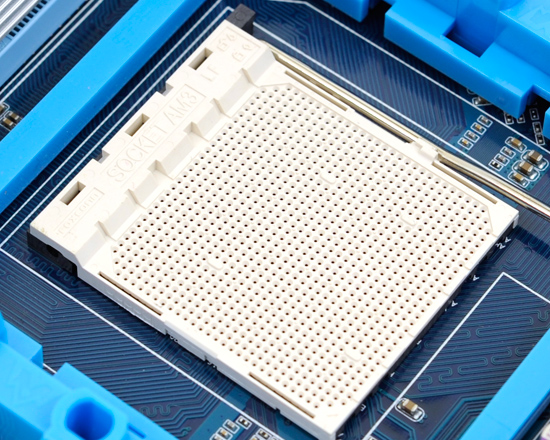
Socket-AM3
Even Socket-AM3 boards will need a BIOS update but those seem a bit more ready to go. Unfortunately because of all of this board switching, some of my 955 numbers aren’t exactly comparable to my older 940 numbers. I’m using different motherboards (Socket-AM3 vs. AM2+) and different memory (DDR3-1333 vs. DDR2-1066). The numbers are close enough, but there were a couple of situations where performance scaled more than it should have or went negative.
Overall it’s not a huge deal but it’s frustrating for anyone looking to save money and upgrade to the 955 but using an older motherboard.
The Move to DDR3: You Can Do It
The Phenom II 955 and 945 support both DDR3 and DDR2 memory. Just a couple of months ago you could save a good amount of money by going with DDR2 over DDR3, but these days the price difference is negligible.
A good pair of 2GB DDR2-1066 sticks will set you back around $57 while a pair of 2GB DDR3-1333 modules will sell for around $60. The problem is that faster DDR3 modules usually have higher latencies associated with them. The table below shows the CAS latency of these modules in ns:
| Memory | DDR2-800 | DDR2-1066 | DDR3-1066 | DDR3-1333 | DDR3-1600 |
| Data Rate | 800MHz | 1066MHz | 1066MHz | 1333MHz | 1600MHz |
| CAS Latency | 4 | 5 | 5 | 7 | 9 |
| CAS Latency in ns | 5 ns | 4.69 ns | 4.69 ns | 5.25 ns | 5.63 ns |
From a latency perspective, DDR2 or DDR3-1066 at CL5 is your best bet. However there is a benefit from having more bandwidth; DDR3-1333 delivers 25% more bandwidth but typical DDR3-1333 modules run at CL7 which translates into 12% higher CAS latency than CL5 at 1066.
The chart below shows the performance improvement from running DDR3-1333 (7-7-7-20) vs. DDR2-1066 (5-5-5-15) on the Phenom II X4 955:
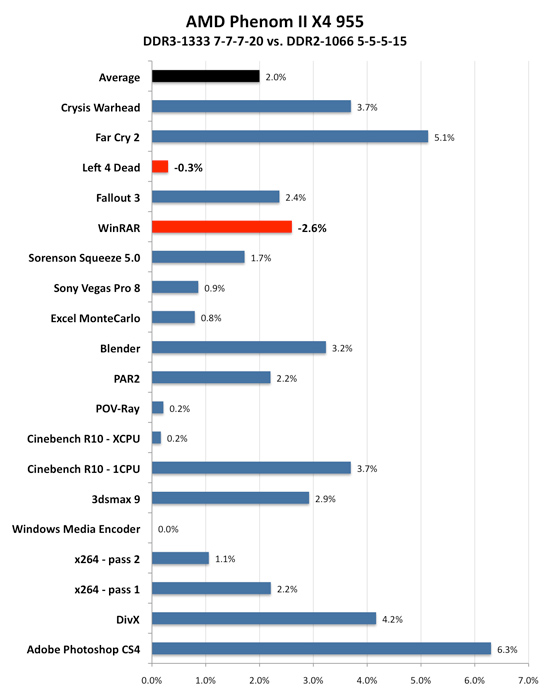
In all but two cases the improved bandwidth, but higher latency DDR3-1333 was faster - but the average performance improvement was only 2%. Some applications managed to see a 5 - 6% increase in performance but overall don’t sweat the difference.
Obviously DDR3 is going to do you more good in the long run so it’s what I’d recommend you stick to if you are building a new system. It’s lasted us a long time and we’ve enjoyed its extreme affordability, but DDR2 is finally on its way out.
The Software Answer to Intel’s Turbo Mode
The Core i7 has its Turbo Mode. When only one core is active, power is shut off to all other cores and the active one can run at higher clock speeds. Even when all four cores are active, as long as the processor isn’t running too hot, the entire chip can run at a higher frequency. The default turbo speeds for the three i7s out on the market are listed below:
| Processor | Stock Clock Speed | Max Turbo (All Four Cores Active) | Max Turbo (One Core Active) |
| Intel Core i7-965 | 3.20GHz | 3.33GHz | 3.46GHz |
| Intel Core i7-940 | 2.93GHz | 3.06GHz | 3.20GHz |
| Intel Core i7-920 | 2.66GHz | 2.80GHz | 2.93GHz |
Turbo mode is an interesting concept because it allows end users to experience higher performance without ever having to even know about overclocking. In its first incarnation on Nehalem, Intel was quite conservative with how far they pushed Turbo. Given that our Core i7 920 had no problems running at up to 3.8GHz without increasing its core voltage, I’d say that Intel could stand to be a bit more aggressive with its turbo modes.
Note that in all of our multithreaded tests, the Core i7 has no problems running at its “turbo” frequency. In other words, the i7-920 runs at 2.80GHz far more frequently than it runs at 2.66GHz.
AMD unfortunately does not have a similar capability in its processors. Intel dedicated around 1M transistors to an on-die microcontroller called the PCU (Power Control Unit). The Core i7’s PCU tracks power consumption and manages clock speeds and voltages to ensure that the i7 always delivers the best performance when you need it, and the lowest power consumption when you don’t.
AMD didn’t go in and introduce any major architectural changes in the Phenom II X4 955 and most likely won't for a while. Instead, AMD is hoping to deliver a turbo-like feature in software.
The software is AMD’s Overdrive Utility 3.0 and the feature is called AMD Smart Profiles.
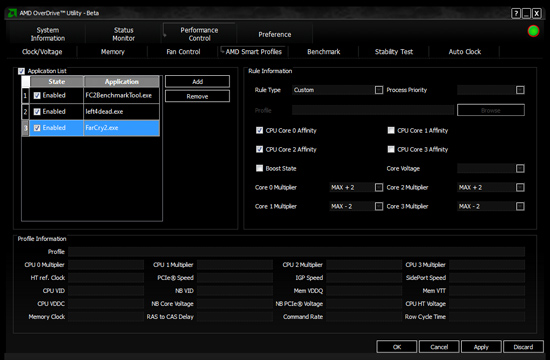
It works like this: you select an executable, and then using AOD3 you can set what cores that executable should run on and what clock speeds those cores should run at. AMD will have predefined profiles for various games but you can also create your own profiles.
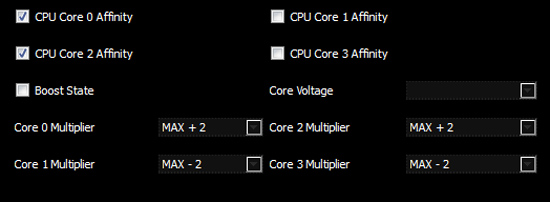
Since the majority of desktop applications aren’t multithreaded, you’d stand to benefit from running two of your cores at a higher frequency and dropping the clock speed on the remaining two cores. That way you could keep power consumption unchanged, while improving performance.
It does work, I ran a quick test on Left 4 Dead and Far Cry 2:
| Processor | Left 4 Dead | Far Cry 2 |
| Smart Profiles Enabled | 124.1 fps | 53.3 fps |
| Smart Profiles Disabled | 121.4 fps | 51.2 fps |
| Performance Improvement | 2.2% | 4.1% |
In these cases the games were forced to run on two cores specifically (at least the .exe files) and those two cores were overclocked by 400MHz, while the remaining two cores were underclocked by 400MHz. The end result was that performance improved by 2% in Left 4 Dead and 4% in Far Cry 2.
There’s obviously more flexibility with AMD’s method than Intel’s and you could potentially get a much greater performance improvement. There are a couple of downsides. For starters, there’s no guarantee of stability but if you keep the overclocks mild and/or accompany them with a corresponding increase in core voltage then you can minimize that risk. The other obvious downside is that for the majority of applications and games you’ll have to create profiles manually. Honestly I’d prefer if the CPU did the work for me, but if you enjoy customizing your system then you’ll feel right at home with AOD3’s Smart Profiles.
AMD will add new profiles as time goes on. AMD does have plans for a turbo mode in future microprocessors, but we won’t see them until 2011.
AMD Black Edition Memory Profiles: One Click Memory Overclocking
There’s another little overclocking improvement that AMD implemented in software: Black Edition Memory Profiles (BEMP).
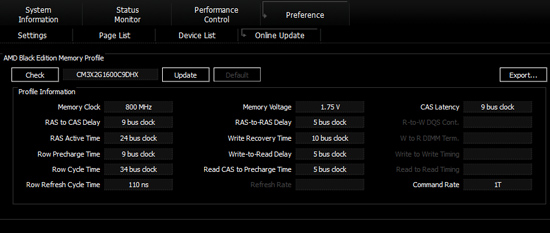
My Corsair memory can run at DDR3-1600 9-9-9-24, AMD's database knows this
If you have a motherboard with an AOD3 compatible BIOS (yes, there is such a thing) and you have a DDR3 memory module that has an AMD Black Edition Memory Profile, you can click one button and your system will overclock its memory to the settings that AMD and the memory vendor guarantee their platform at.
The memory/participating vendors list is as follows:
| Manufacturer | Memory Module(s) |
| Corsair | CM3X2G1600C9DHX |
| Kingston | KHX11000D3LLK2/2G KHX12800D3K2/2G |
| Mushkin | 991629 |
| OCZ | OCZ3AMD18002G |
Yep, it’s not very long. But the effect is pretty neat. The AOD3 utility connects to AMD’s online database and finds your memory. It retrieves what settings AMD and the memory vendor agree will work and then applies them to your system. A simple reboot later and you have an overclocked un-core and DDR3 memory. The table below shows you what will happen:
| Rated DDR3 Speed | 1333MHz | 1600MHz |
| NB Frequency | 2200MHz | 2400MHz |
| NB Voltage | 1.200V | 1.300V |
The memory timings and voltages are also properly set. Unfortunately with my Gigabyte 790FX board there’s a bug where instead of setting the BEMP compliant Corsair memory to 1.75V it sets it to 1.70V which isn’t stable. AMD is clearly still working out bugs in the system, but thankfully it’s software so those bugs can be worked out.
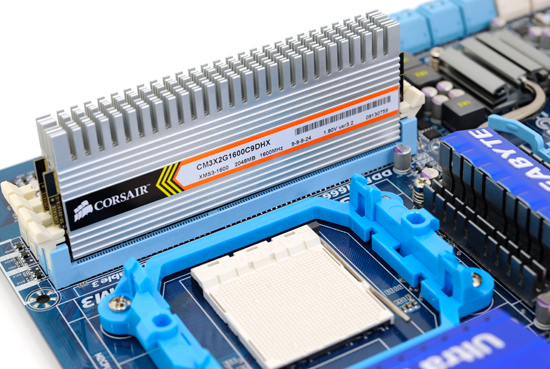
These Corsair modules support BEMP
Additionally, you can always create your own profiles to avoid mishaps like this one. What sort of performance boost can a single click yield? The graph below shows you:
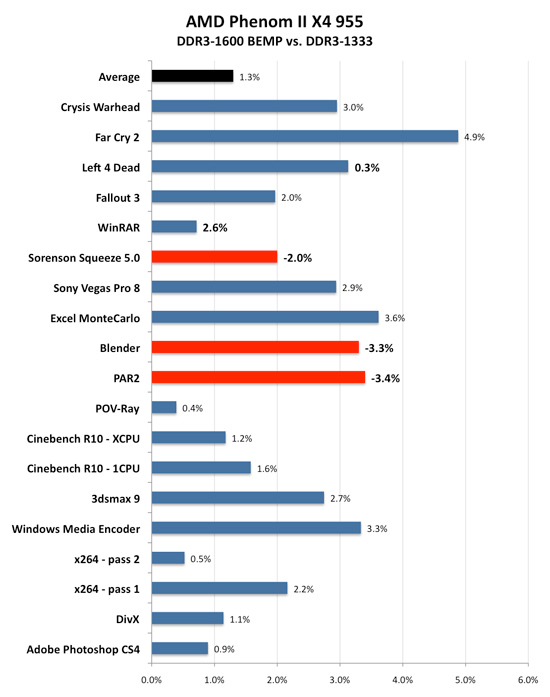
The average increase in performance was only 1.3%, mostly due to the fact that some numbers went down. The problem is that DDR3-1333 (my default speed) at CL7 is lower latency than DDR3-1600 at CL9; applications that can’t use the added bandwidth are penalized by the longer memory access latency. That being said, some applications did show performance boosts from 1 - 5%. Is it enough for me to specifically buy memory that has a Black Edition Memory Profile? No, but it’s a nice convenience if you happen to have some.
Overclocking – Adventures in Frustration
Test Setup
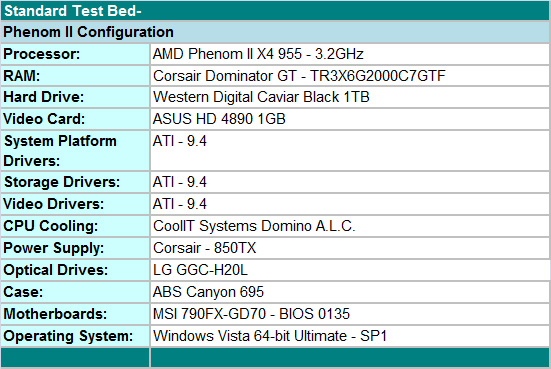
We put an emphasis on stability during our testing sessions so we test with real world applications ranging from a variety of games to digital imaging software to various audio/video creation programs, along with the normal OCCT and PCMark / 3DMark Vantage tests. We focus on the type of overclocks that support 24/7 operation with reasonable cooling and the ability to run a multitude of programs without a problem. We are not optimizing for SuperPI or 3DMark records. It's more like trying to keep our system stable under a variety of conditions while being properly tuned for performance.
One of the most critical aspects in overclocking is the quality of the processor. We are testing with an early retail unit based on the 0907APMW lot code. We cannot print the words to fully describe our overclocking experience with this particular CPU, let’s just say it was not a pleasant experience. The good news is that we have another retail 955 BE CPU based on lot code CACYC 0911EPMW arriving shortly for further overclocking tests. Besides having a strong processor, a well-engineered motherboard, premium memory, excellent cooling, and proper power supply are all essential elements in obtaining stable and high clock speeds when overclocking.
With that in mind, we are utilizing the MSI 790FX-GD70 (790FX) motherboard for testing today. We had similar clocking results with the ASUS M4A79T Deluxe and Gigabyte GA-MA790FXT-UD5P motherboards. At this time, we slightly prefer the MSI board based on cost, features, layout, and performance. We also tossed in the Corsair 850TX power supply along with one of the best memory kits we have ever used, the Corsair TR3X6G2000C7GTF DDR3-2000 (4GB) kit. Yes, this kit is overkill for the AM3 platform, but we wanted to ensure memory clocks or timings would not hold us back. The balance of the test system consists of a WD Caviar Black 1TB HD, Blu-ray drive from LG, Vista 64 Ultimate, and our ABS Canyon 695 case.
In a twist from our normal overclocking results, we decided to utilize the CoolIT Systems Domino A.L.C. cooler that offered a great experience when overclocking our Intel i7 920 D0 processor. Today’s test results are based on how high we could overclock on stock voltages and then by increasing voltages until we ran out of cooling headroom with the Domino cooler. Unfortunately, we never reached the limits of this cooler due to continuing problems with the Phenom II processor family and Vista 64 not allowing overclocks over 4GHz without cooling the CPU to near zero temperatures. The retail cooler would have sufficed for testing as it offered the same clock rates and voltages as our other coolers based on the operating system of choice.
On a side note, we made it to 4.2GHz on 1.50V under Vista 32 SP1, but we are still experiencing memory stability problems above DDR3-1640 with this setup. This brings us to a general problem we have noticed in testing several 790FX/790GX AM3 motherboards. DDR3 memory clocking is not very robust at this point, especially if you are expecting stable memory clocks above DDR3-1640 with 4GB or more of memory.
We have seen gradual improvement in the latest BIOS releases but for all intent and purposes, the platform performs almost equally at 1333 as it does at 1600 depending on timings. AMD designed it this way as the IMC is set up to perform best at lower memory clock speeds with tight timings. However, this does not always hold true. We have already experienced several instances where 1333 5-5-5-18 is faster than 1480 5-5-5-18 or 1600 6-7-6-20 is faster than 1800 7-7-7-24, but 1720 9-9-9-20 1T is fastest overall. At this point, we recommend DDR3-1333 5-5-5-18 1T or DDR3-1600 6-7-6-20 1T timings for the majority of users. Obviously, those benchmarking for records will want to utilize a 2GB setup and find optimal timings and speeds around DDR3-1680 to DDR3-1800, provided anything over 1700 is stable enough for benchmarking.
Phenom II X4 955 BE Maximum Overclock on Stock Voltages

Our maximum overclock on stock Core VID with the X4 955 BE resulted in a 3.8GHz clock speed at a respectable 2606MHz HT link speed and Northbridge clock at 2606MHz. Memory speed is set to DDR3-1336 at 6-6-6-18 1T on 1.50V. The primary voltages settings were left at auto in the BIOS. We tried a variety of memory speeds and timings and still ended up at 1336 on stock voltages, a slight bump to 1.55V netted us DDR3-1600 at 6-7-6-18 1T timings, although performance was nearly identical.
Phenom II X4 955 BE Maximum CPU/HT Ref Clock on Stock Voltages
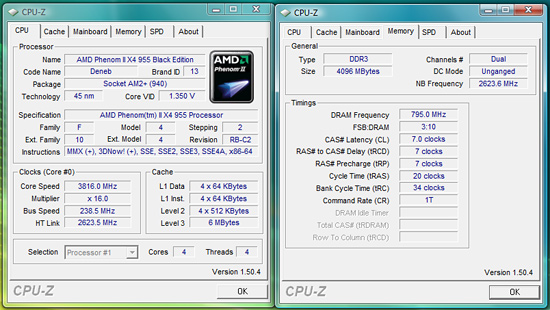
Our maximum overclock on stock Core VID with HT ref clocking resulted in a 3.81GHz clock speed with a 238 HT ref clock and Northbridge speed of 2623MHz. Memory speed is set to DDR3-1590 at 7-7-7-20 1T on 1.50V. Performance in several applications was basically identical to our stock 3.8GHz overclock as memory performance did not improve enough to make a measurable difference.
Phenom II X4 955 BE Maximum CPU Overclock
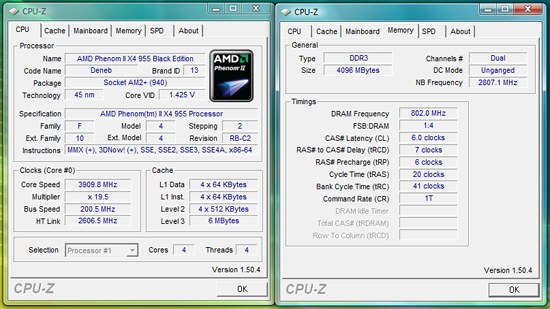
Our maximum CPU overclock put us at a disappointing (embarrassing) 3.90GHz with HT link speed at 2606MHz and Northbridge speed at 2807MHz. Memory speed is set to DDR3-1604 at 6-7-6-18 1T on 1.65V. Core VID is at 1.425V and NB VID at 1.30V to ensure 24/7 stability. We tried a variety of CPU multipliers, voltages, and memory speeds but continually ran into stability problems as we approached 4GHz under Vista 64.
Phenom II X4 955 BE Maximum CPU/HT Ref Clock Speed
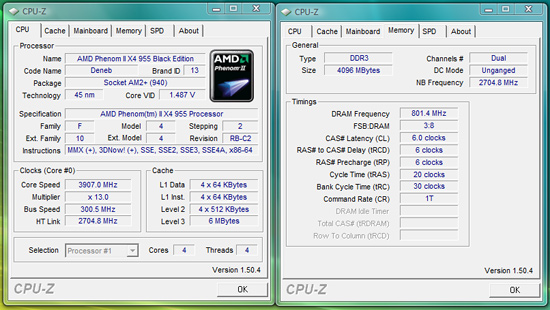
Our maximum CPU/HT Ref Clock settings resulted in a final processor speed of 3.907GHz. We set our HT Ref clock to 300, CPU multiplier to 13x, HT Link to 2704MHz, and NB speed to 2704MHz for this particular overclock. Memory was set to DDR3-1602 at 6-6-6-20 1T timings on 1.65V. Unfortunately, due to the HT ref clock speed, we had to increase our Core VID to 1.4875V and NB VID to 1.4375V to maintain stability. Performance was nearly identical to our 3.9GHZ utilizing just the CPU multiplier for clocking.
| Processor | Highest Overclock (Stock Voltage) | Highest Overclock (Overvolted) | % Increase over stock | Overvolted Vcore |
| AMD Phenom II X4 955 BE (3.2GHz - 1.345V) | 3.8GHz | 3.9GHz | 22% | 1.425V |
| AMD Phenom II 720 BE (2.8GHz - 1.325V) | 3.36GHz | 3.81GHz | 36% | 1.50V |
| Intel Core i7-920 C0 (2.66GHz - 1.32V) | 3.83GHz | 4.0GHz | 50% | 1.35V |
| Intel Core 2 Quad Q9550 (2.86GHz - 1.22V) | 3.48GHz | 3.91GHz | 38% | 1.35V |
We disabled the power management features and manually set the voltages to stock VID values. Leaving the BIOS settings at Auto will generally result in the BIOS auto-leveling voltages to handle the increased clock speeds for the processor, memory, and bus speeds.
We are basically OS limited with the Phenom II X4 955 BE processor. We hit 4.2GHz under Vista 32 SP1 but needed 1.50V to do it. Even so, we noticed our particular CPU sample just does not like core speeds over 4.1GHz without ramping voltages and improved cooling. We will revisit our overclocking results once additional retail units arrive. The results for the two Intel processors are very good in this particular test with the X3 720 BE managing a respectable 36% improvement in clock speeds.
The New Heatsink and The Test
AMD wanted us to point out that it has started shipping a new heatsink/fan with its boxed processors:


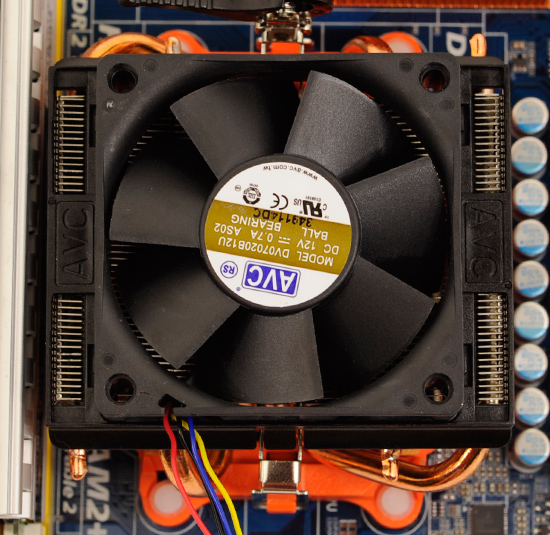
The heatsink worked fine in our testing (although its retention mechanism was a little awkward). The cooler itself definitely wasn't silent. If you're in search of a truly silent PC you'll want to go aftermarket. That being said, it was quiet enough if you're used to most boxed coolers.
| Motherboard: | Intel DX58SO (Intel X58) Intel DX48BT2 (Intel X48) MSI DKA790GX Platinum (AMD 790GX) Gigabyte GA-MA790GP-DS4H (AMD 790GX) Gigabyte GA-MA790FX-UD5P (AMD 790FX) |
| Chipset: | Intel X48 Intel X58 AMD 790GX AMD 790FX |
| Chipset Drivers: | Intel 9.1.1.1010 (Intel) AMD Catalyst 8.12 |
| Hard Disk: | Intel X25-M SSD (80GB) |
| Memory: | G.Skill DDR2-800 2 x 2GB (4-4-4-12) G.Skill DDR2-1066 2 x 2GB (5-5-5-15) Qimonda DDR3-1066 4 x 1GB (7-7-7-20) Corsair DDR3-1333 2 x 2GB (7-7-7-20) |
| Video Card: | eVGA GeForce GTX 280 |
| Video Drivers: | NVIDIA ForceWare 180.43 (Vista64) NVIDIA ForceWare 178.24 (Vista32) |
| Desktop Resolution: | 1920 x 1200 |
| OS: | Windows Vista Ultimate 32-bit (for SYSMark) Windows Vista Ultimate 64-bit |
SYSMark 2007 Performance
Our journey starts with SYSMark 2007, the only all-encompassing performance suite in our review today. The idea here is simple: one benchmark to indicate the overall performance of your machine.
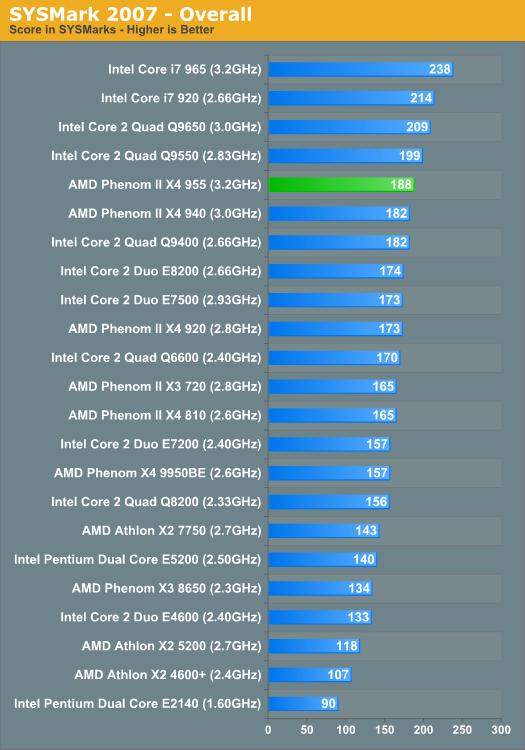
We start off with the Phenom II X4 955 trailing the Q9550, the Intel chip taking the 6% lead. You'll see these two trade blows quite a few times over the next few pages.
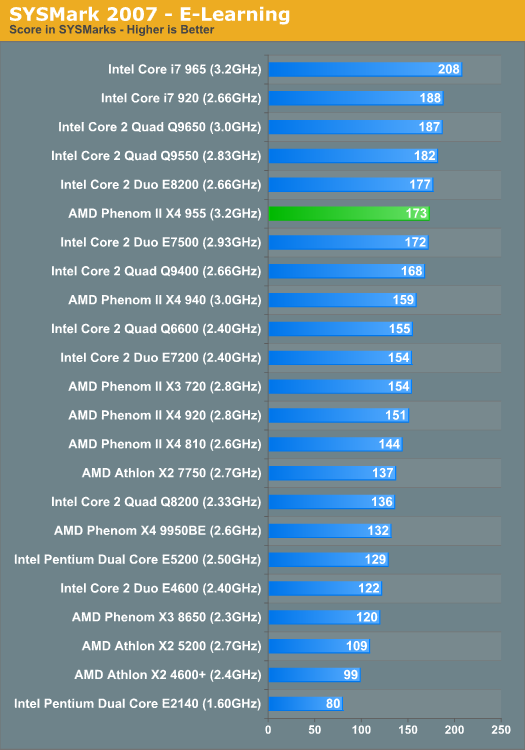
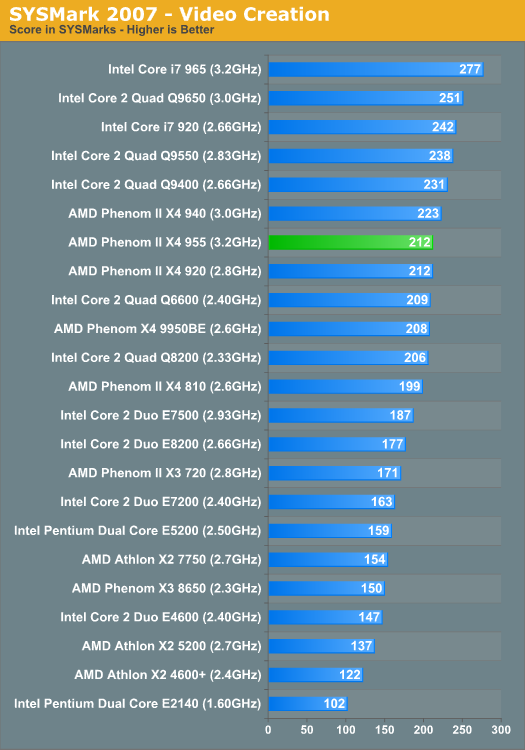
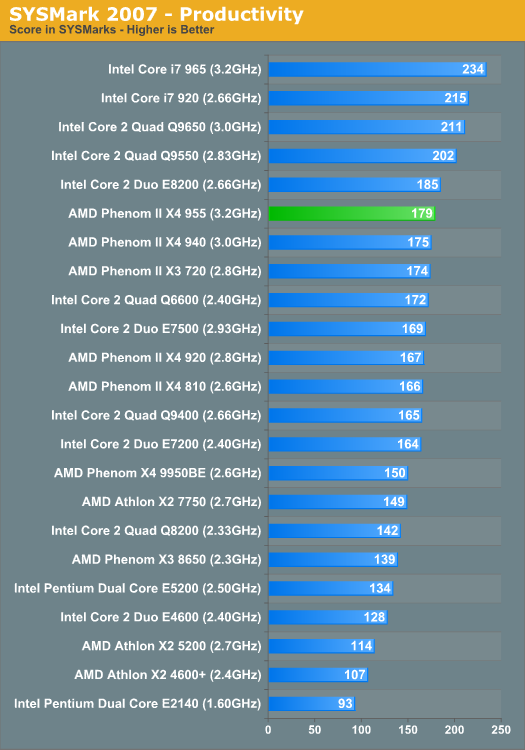
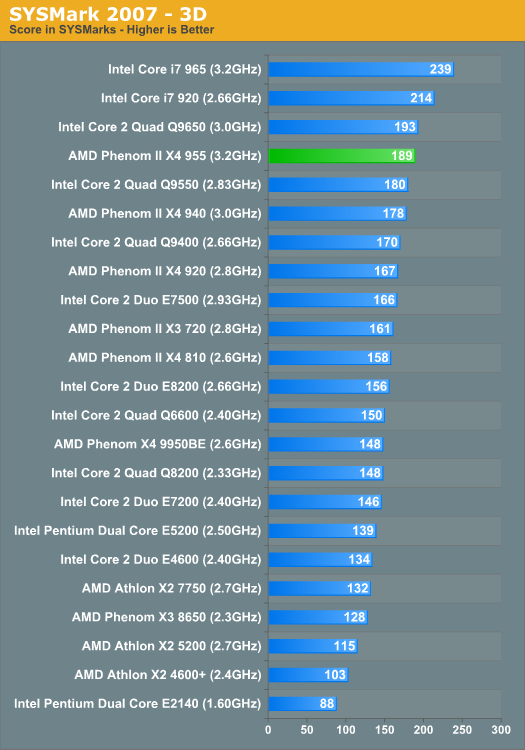
Adobe Photoshop CS4 Performance
To measure performance under Photoshop CS4 we turn to the Retouch Artists’ Speed Test. The test does basic photo editing; there are a couple of color space conversions, many layer creations, color curve adjustment, image and canvas size adjustment, unsharp mask, and finally a gaussian blur performed on the entire image.
The whole process is timed and thanks to the use of Intel's X25-M SSD as our test bed hard drive, performance is far more predictable than back when we used to test on mechanical disks.
Time is reported in seconds and the lower numbers mean better performance. The test is multithreaded and can hit all four cores in a quad-core machine.
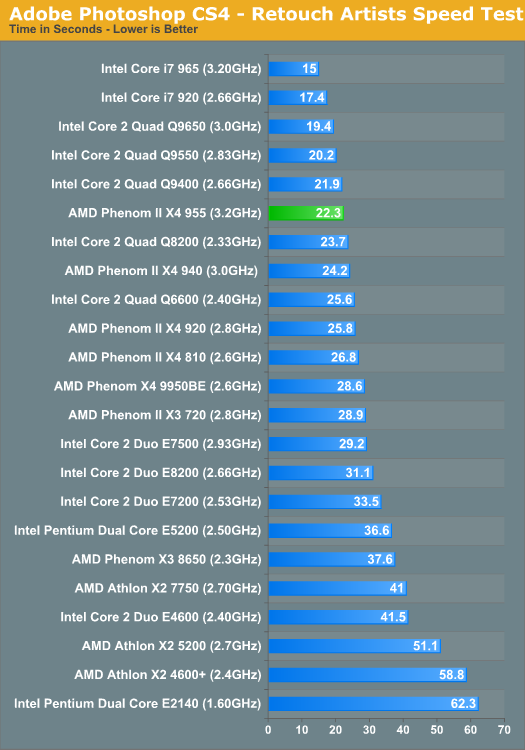
Photoshop CS4 continues to be more comfortable with Intel CPUs, as even the Core 2 Quad Q9400 is able to outperform the X4 955. The cream of the crop here is Intel's Core i7 though, even a 920 is able to outperform the fastest Core 2 Quad we have here.
DivX 8.5.3 with Xmpeg 5.0.3
Our DivX test is the same DivX / XMpeg 5.03 test we've run for the past few years now, the 1080p source file is encoded using the unconstrained DivX profile, quality/performance is set balanced at 5 and enhanced multithreading is enabled:
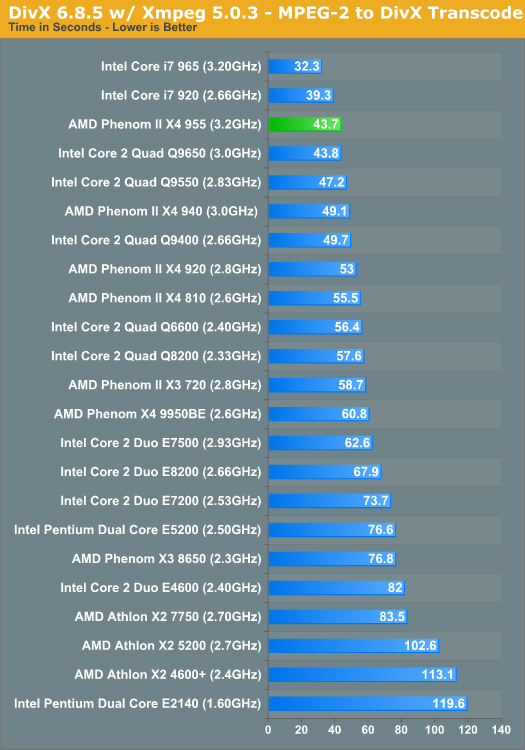
Finally, after struggling far too long in our DivX encoding test AMD is now able to claim a spot in the top three. While it's still slower than the Core i7 920, the Phenom II X4 955 is faster than any Core 2 Quad on the list when it comes to DivX encoding.
x264 HD Video Encoding Performance
Graysky's x264 HD test uses the publicly available x264 codec (open source alternative to H.264) to encode a 4Mbps 720p MPEG-2 source. The focus here is on quality rather than speed, thus the benchmark uses a 2-pass encode and reports the average frame rate in each pass.
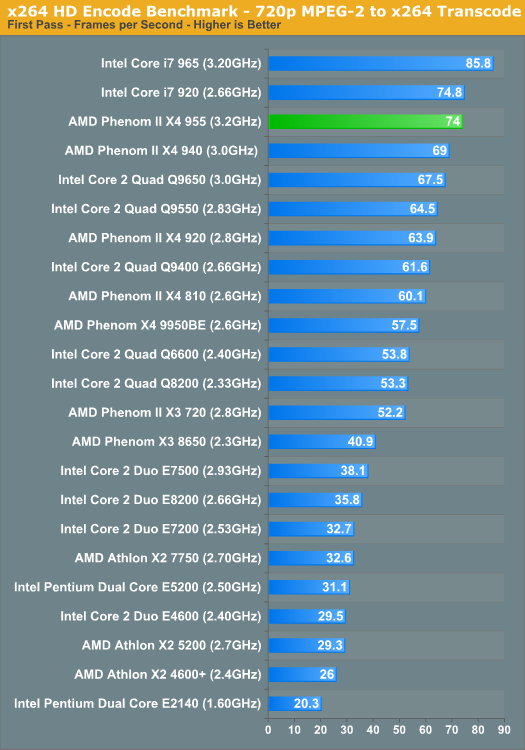
More important than DivX encoding performance is x264 encoding performance these days, and the Phenom II X4 955 does quite admirably here as well. The second pass is the more interesting one as that's the more strenuous pass:

The 955 is a hair faster than the Q9550 but unable to touch the Core i7 920.
Windows Media Encoder 9 x64 Advanced Profile
In order to be codec agnostic we've got a Windows Media Encoder benchmark looking at the same sort of thing we've been doing in the DivX and x264 tests, but using WME instead.
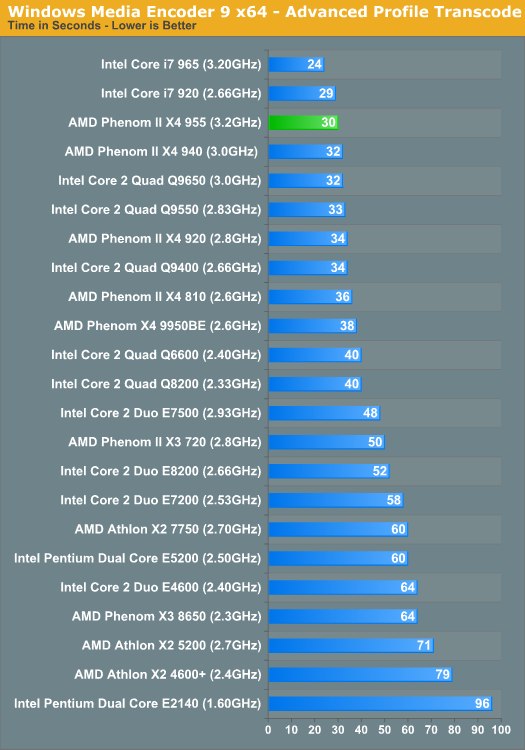
Once again, short of the i7, the Phenom II X4 955 is the fastest quad-core here.
3dsmax 9 - SPECapc 3dsmax CPU Rendering Test
Today's desktop processors are more than fast enough to do professional level 3D rendering at home. To look at performance under 3dsmax we ran the SPECapc 3dsmax 8 benchmark (only the CPU rendering tests) under 3dsmax 9 SP1. The results reported are the rendering composite scores:
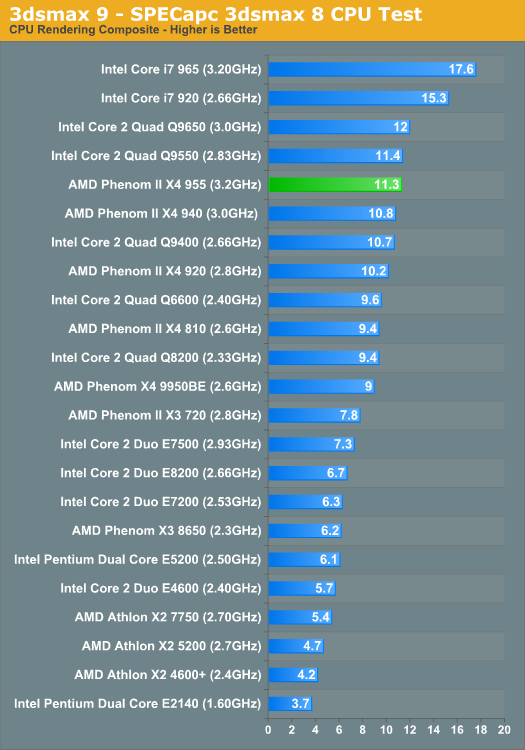
Even 3D rendering performance under 3dsmax 9 is quite competitive. Both the 955 and 940 are able to hang with the Q9400 and Q9550. Once again, the i7s hold a generational gap advantage in performance.
Cinebench R10
Created by the Cinema 4D folks we have Cinebench, a popular 3D rendering benchmark that gives us both single and multi-threaded 3D rendering results.
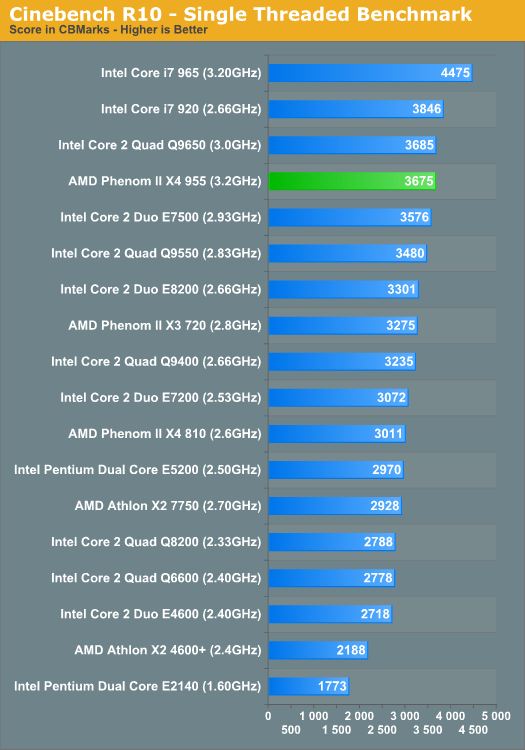
Single or multi-threaded, the 955 is faster than the Q9550 here. But if you're serious about 3D rendering you'll want the Core i7.
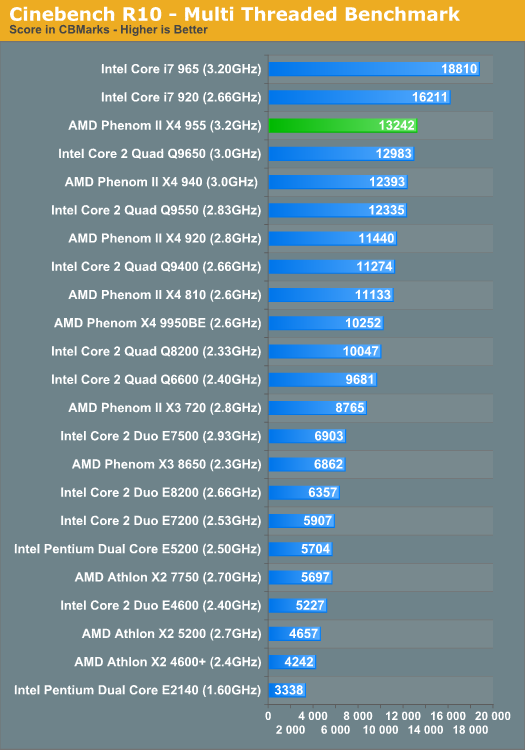
POV-Ray 3.73 beta 23 Ray Tracing Performance
POV-Ray is a popular, open-source raytracing application that also doubles as a great tool to measure CPU floating point performance.
I ran the SMP benchmark in beta 23 of POV-Ray 3.73. The numbers reported are the final score in pixels per second.
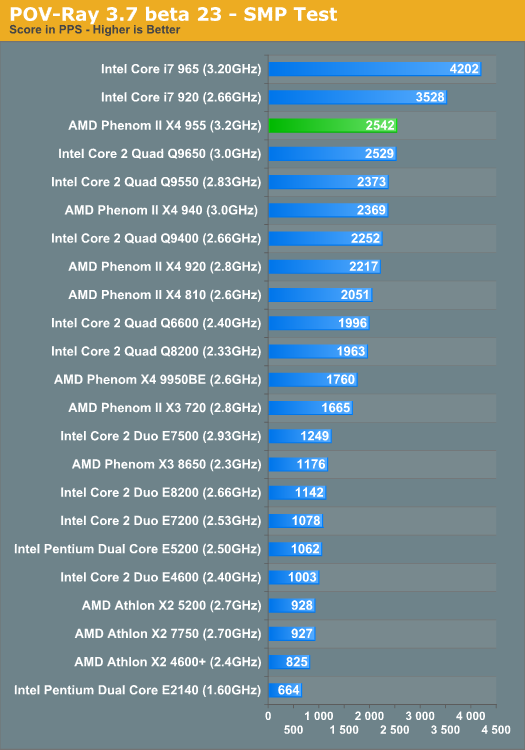
PAR2 Multithreaded Archive Recovery Performance
Par2 is an application used for reconstructing downloaded archives. It can generate parity data from a given archive and later use it to recover the archive
Chuchusoft took the source code of par2cmdline 0.4 and parallelized it using Intel’s Threading Building Blocks 2.1. The result is a version of par2cmdline that can spawn multiple threads to repair par2 archives. For this test we took a 708MB archive, corrupted nearly 60MB of it, and used the multithreaded par2cmdline to recover it. The scores reported are the repair and recover time in seconds.
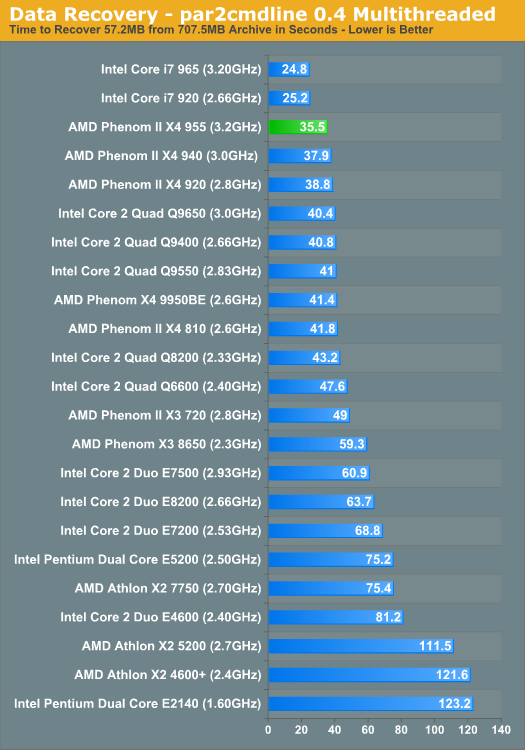
AMD's Phenom II has traditionally done quite well in our PAR2 recovery test, the 955 continues the tradition. It's the i7's Hyper Threading that gives it the significant edge here, but the Q9550 can't stand a chance.
Blender 2.48a
Blender is an open source 3D modeling application. Our benchmark here simply times how long it takes to render a character that comes with the application.
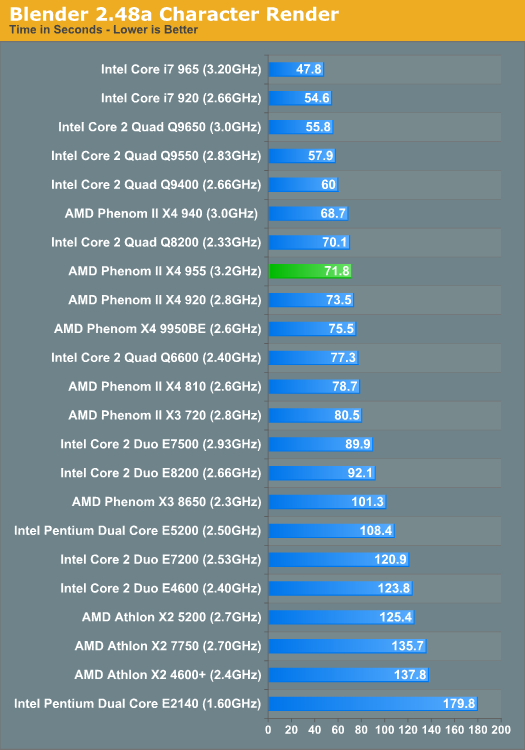
This is one of those unfortunate cases where switching platforms actually robbed us of performance, the 955 should outperform the 940 here but it put out numbers a bit slower than our older AM2+ platform which unfortunately doesn't have support for the new CPU just yet. Either way, the Q9550 is too far ahead to be toyed with.
Microsoft Excel 2007
Excel can be a very powerful mathematical tool. In this benchmark we're running a Monte Carlo simulation on a very large spreadsheet of stock pricing data.
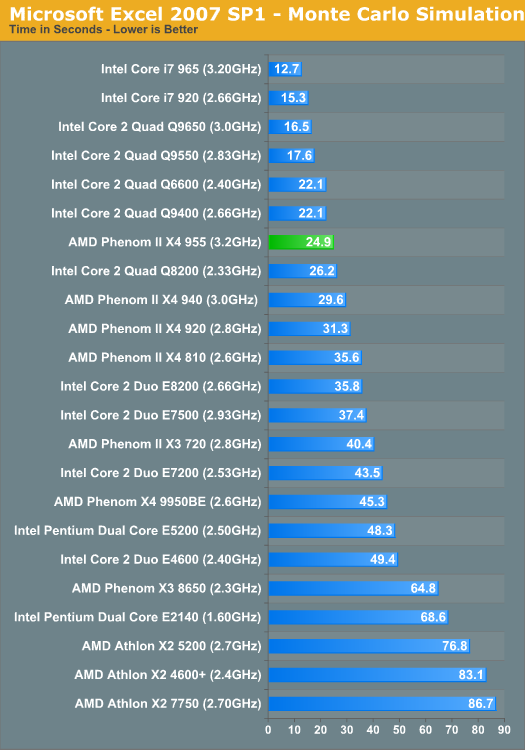
In those scenarios where Intel has a distinct architectural or optimization advantage, the Phenom II doesn't stand a chance. That is unfortunately one downside AMD has to deal with. Intel's developer relations team is much larger and works much harder to ensure that more applications and workloads are optimized as best as possible for Intel CPUs.
Sony Vegas Pro 8: Blu-ray Disc Creation
Although technically a test simulating the creation of a Blu-ray disc, the majority of the time in our Sony Vegas Pro benchmark is spent encoding the 25Mbps MPEG-2 video stream and not actually creating the Blu-ray disc itself.
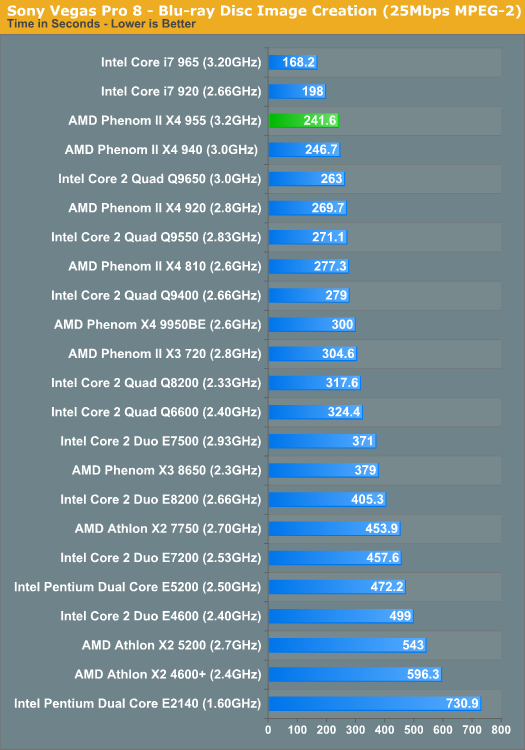
Making a Blu-ray disc is still mostly an encoding task, which once again falls right into the Phenom II's strengths. If you can't afford an i7 system, a Phenom II 955 or even a 940 will do quite well here.
Sorenson Squeeze: FLV Creation
Another video related benchmark, we're using Sorenson Squeeze to convert regular videos into Flash videos for use on websites.

We see more of the same here - the Phenom II X4 955 outperforms even the Q9650.
WinRAR - Archive Creation
Our WinRAR test simply takes 300MB of files and compresses them into a single RAR archive using the application's default settings. We're not doing anything exotic here, just looking at the impact of CPU performance on creating an archive:
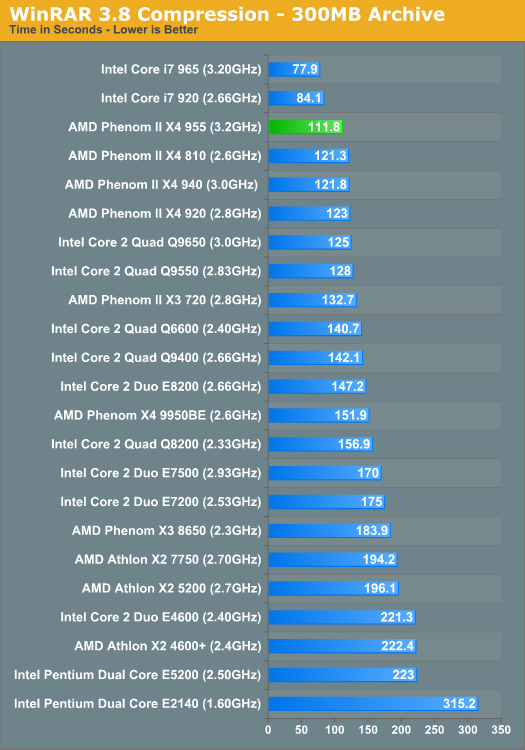
Fallout 3 Game Performance
Bethesda’s latest game uses an updated version of the Gamebryo engine (Oblivion). This benchmark takes place immediately outside Vault 101. The character walks away from the vault through the Springvale ruins. The benchmark is measured manually using FRAPS.
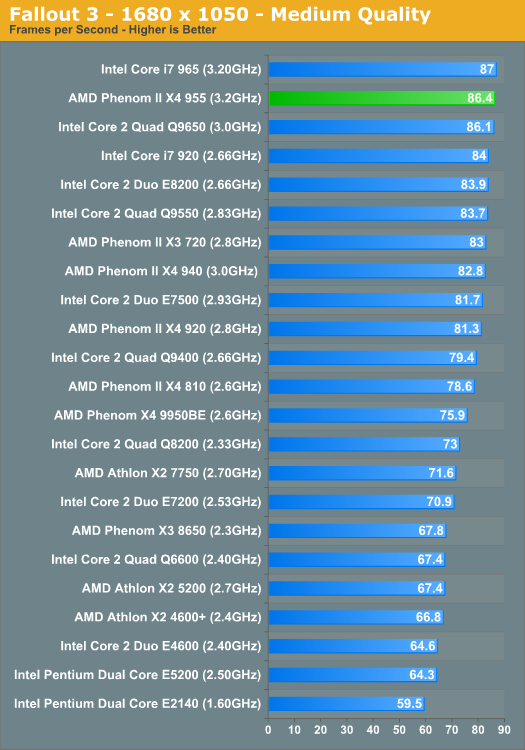
Gaming performance is a particularly strong suit of the Phenom II processor, here it is actually faster than the i7-920 although not by a noticeable margin.
Left 4 Dead
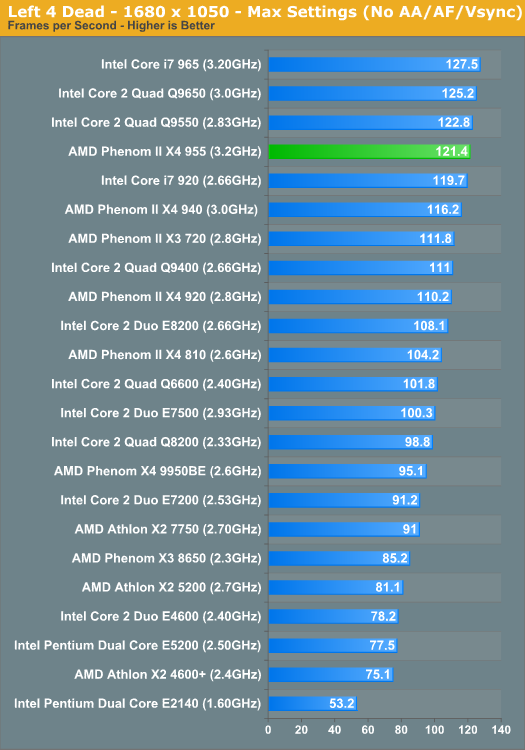
FarCry 2 Multithreaded Game Performance
FarCry 2 ships with the most impressive benchmark tool we’ve ever seen in a PC game. Part of this is due to the fact that Ubisoft actually tapped a number of hardware sites (AnandTech included) from around the world to aid in the planning for the benchmark.
For our purposes we ran the CPU benchmark included in the latest patch:
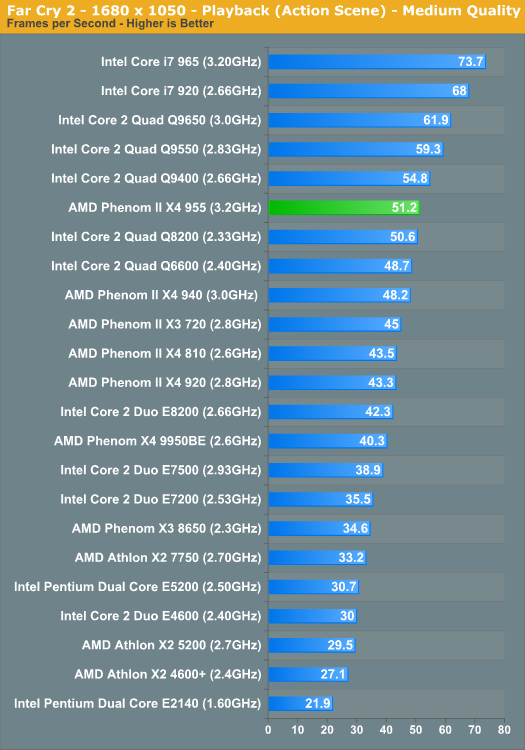
The Far Cry 2 engine appears to put a greater focus on threading, which may prove to be the case with future titles as well - the end result is the i7s do quite well and the Phenom II actually falls behind the Q9400.
Crysis Warhead
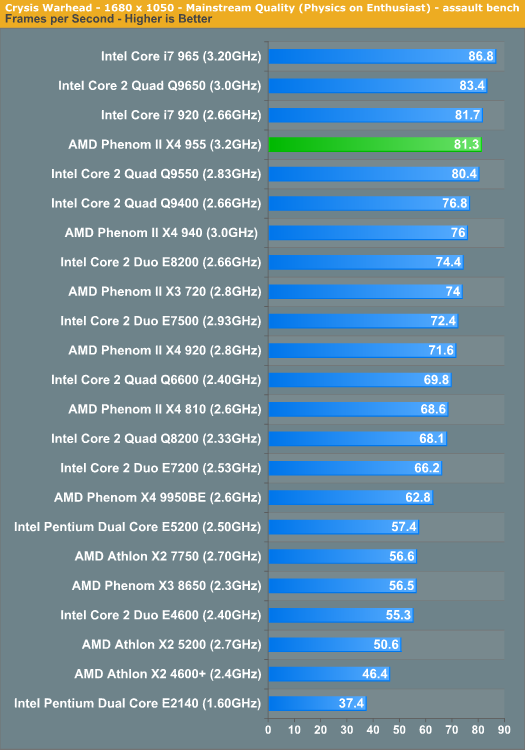
The 955 just edges out the Q9550 under Crysis Warhead. The i7 continues to lead in performance.
Power Consumption
The Phenom II X4 955 draws slightly more power than the Core 2 Quad Q9550, but not by a significant amount. Based on its performance, the 955 takes the energy efficiency crown away from the Q9550 in the majority of our tests.
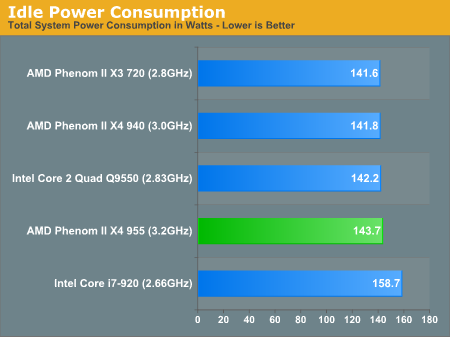
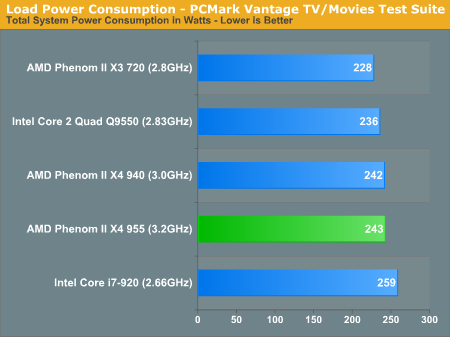
Final Words
It has taken AMD more than long enough, but the company is finally in a situation where its processors are competitive in the performance mainstream market segment. The Phenom II X4 955, 945/940 and the Phenom II X3 720 are all very competitive at their price points. Compared to the Core 2 Quad Q9550 the new X4 955 generally comes out ahead.
From a longevity standpoint, the AM3 platform is much wiser to invest in than LGA-775. Intel has already shown all of its cards there, and there aren't going to be any faster Core 2 Quads - just cheaper ones. By the end of this year Intel will begin transitioning to LGA-1156 and 775 will start fading away. By contrast, AMD's Socket-AM3 is going to be the flagship for the company for all of 2009 and it'll continue to live on into 2010. If you're choosing between Socket-AM3 and LGA-775, AMD has made that choice very easy - Phenom II is the way to go if you're concerned about a long term upgrade path, not to mention that the chips are generally cheaper than their Intel equivalents.
Where the situation gets tougher is when you look at the $245 Phenom II 955 vs. Intel's $284 Core i7-920. The i7 route costs you another ~$40 on the CPU and another $10 - $70 on the motherboard depending on what AM3 board you get for the 955. For around $100 extra you can go with an i7-920, which is anywhere from 0 - 40% faster than the Phenom II X4 955 depending on what application you're looking at. Now if you're budget constrained then the i7 isn't really an option, but as applications and workloads become more threaded the i7 could be a wiser long-term purchase.
The cheaper Phenom II parts, especially once you get down to the X3 720, don't really even touch the i7's price points so the comparison isn't really valid there. But the 955 is getting dangerously close to the cost of an entry level i7 platform, and if you don't already have an AM2+ motherboard the i7 may be worth considering. Especially now that DDR2 and DDR3 are much closer in price.
























